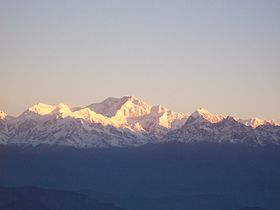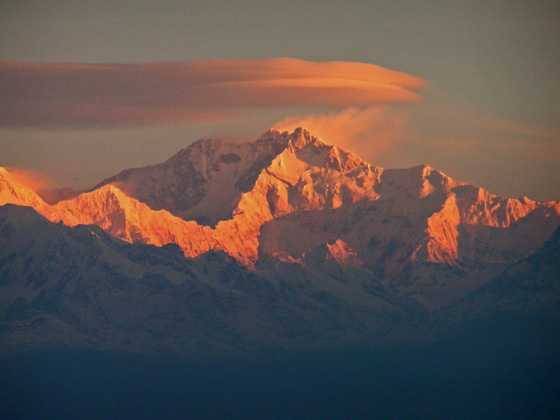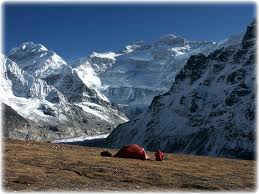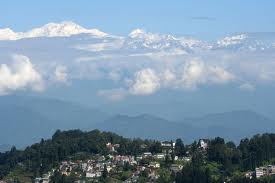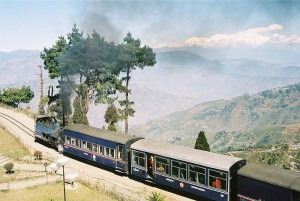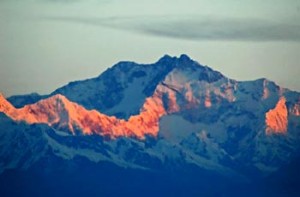India /Sikkiml /North Sikkim /North Sikkim
Sight Address : Kanchenjunga Mountain, North Sikkim, Darjeeling, India Edit
Detail InformationEdit
Kangchenjunga is the third highest mountain in the world. It rises with an elevation of 8,586 m (28,169 ft) in a section of the Himalayas called Kangchenjunga Himal that is limited in the west by the Tamur River and in the east by the Tista River. Kangchenjunga is located on the boundary between Nepal and the Indian state of Sikkim. The Geological Survey of India indicates the summit of Kangchenjunga at 8,598 m (28,209 ft).It is the highest peak in India and the easternmost of the peaks higher than 8,000 m (26,000 ft). It is called Five Treasures of Snow after its five high peaks, and has always been worshipped by the people of Darjeeling and Sikkim. The treasures represent the five repositories of God, which are gold, silver, gems, grain, and holy books.[citation needed Three of the five peaks – main, central, and south – are on the border of North Sikkim in India and Taplejung District of Nepal, while the other two are completely in Taplejung District.Until 1852, Kangchenjunga was assumed to be the highest mountain in the world, but calculations based on various readings and measurements made by the Great Trigonometric Survey of India in 1849 came to the conclusion that Mount Everest, known as Peak XV at the time, was the highest. Allowing for further verification of all calculations, it was officially announced in 1856 that Kangchenjunga is the third-highest mountain. Kangchenjunga was first climbed on May 25, 1955 by Joe Brown and George Band, who were part of a British expedition. They stopped short of the summit as per the promise given to the Maharaja of Sikkim that the top of the mountain would remain inviolate. Every climber or climbing groups that have reached the summit have have followed this tradition.Kanchenjunga is the third highest mountain in the world (the first two being Mount Everest and K2), standing at an altitude of 8586 m. There are five peaks in Kanchenjunga. If you watch Kanchenjunga from the Observatory Hills, you might be deceived that the mount is a calm and serene upheaval of ice and snow.In reality, rock and ice avalanches more often thunder this ostensibly serene mount. There are not any direct routes to the mount. One has to try various indirect routes, probably starting by ascending any one of the five peaks, then finding any possible place for camping, and attempting the summit. As hardship it may give, a visit to Kanchenjunga is memorable. Kangchenjunga translated means “The Five Treasures of Snows”, as it contains five peaks, four of them over 8,450 metres, the treasures representing the five repositories of God, which are gold, silver, gems, grain, and holy books. Kangchenjunga is also called Sewa Lungma in the local Limbu language and is considered sacred in the Kirat religion. Three of the five peaks (main, central, and south) are on the border of North Sikkim district of Sikkim, India and Taplejung District of Nepal, while the other two are completely in Taplejung District. Although Kangchenjunga is the official spelling adopted by Douglas Freshfield, A.M. Kellas, and the Royal Geographical Society that gives the best indication of the Tibetan pronunciation, there are a number of alternative spellings which include Kangchen Dzö-nga, Khangchendzonga, Kanchenjanga, Kachendzonga, Kanchenjunga or Kangchanfanga.
The final word on the use of the name Kangchenjunga came from His Highness Sir Tashi Namgyal, the Maharaja or Chogyal of Sikkim, who stated that “although junga had no meaning in Tibetan, it really ought to have been Zod-nga (treasure, five) Kang-chen (snow, big) to convey the meaning correctly”. Following consultations with a Lieutenant-Colonel J.L.R. Weir (HMG political agent to Sikkim), he agreed that it was best to leave it as Kangchenjunga, and thus the name remained so by acceptance and usage.
HistoryEdit
Between April 1848 and February 1849, Joseph Dalton Hooker explored parts of northern Sikkim and eastern Nepal, mainly to collect plants and study the distribution of Himalayan flora. He was based in Darjeeling, and made repeated excursions in the river valleys and into the foothills of Kangchenjunga up to an altitude of 15,620 ft (4,760 m).In spring 1855, the German exlorer Hermann Schlagintweit travelled to Darjeeling but was not allowed to proceed further north due to the Nepalese-Tibetan War. In May, he explored the Singalila Ridge up to the peak of Tonglo for a meteorological survey.In 1883, a party of William Woodman Graham, the British pioneer of Himalayan mountaineering, claimed to have circumnavigated the mountain in March 1882. After climbing an 18,000 ft (5,500 m) peak, they were forced to return to Darjeeling after only a week. They returned in July 1883 with two Swiss guides for a purported attempt whilst climbing other peaks in the area and hunting snow leopard.In 1899, British mountaineer Douglas Freshfield set out with his party comprising the Italian photographer Vittorio Sella. They were the first mountaineers to examine the lower and upper ramparts, and the great western face of Kangchenjunga, rising from the Kangchenjunga Glacier. In 1905, a party headed by Aleister Crowley was the first attempt at climbing the mountain. Aleister Crowley had been part of the team attempting the 1902 ascent of K2. The team reached an estimated altitude of 6,500 m (21,300 ft) on the southwest side of the mountain before turning back. The exact height reached is somewhat unclear; Crowley stated that on August 31, “We were certainly over 21,000 ft (6,400 m) and possibly over 22,000 ft (6,700 m)”, when the team was forced to retreat to Camp 5 by the risk of avalanche. On September 1, they evidently went further; some members of the team (Reymond, Pache and Salama) “got over the bad patch” that had forced them to return to Camp 5 the day before, and progressed “out of sight and hearing” before returning to Crowley and the men with packs, who could not cross the dangerous section unassisted with their burdens. It is not clear how far Reymond, Pache and Salama had ascended – but in summarizing, Crowley ventured “We had reached a height of approximately 25,000 ft (7,600 m).” Attempting a “mutinous” late-in-the-day descent from Camp 5 to Camp 4, climber Alexis Pache (who earlier that day had been one of three to ascend possibly higher than any before), and three local porters, were killed in an avalanche. Despite the insistence of one of the men that “The demon of Kangchenjunga was propitiated with the sacrifice”, Crowley decided enough was enough and that it was inappropriate to continue. In 1929, a German expedition led by Paul Bauer reached 7,400 m (24,280 ft) on the northeast spur before being turned back by a five-day storm. In 1930, an international expedition led by George Dyhrenfurth, German Uli Wieland, Austrian Erwin Schneider and Englishman Frank Smythe (who published “The Kangchenjunga Adventure” in the same year). The attempt failed due to poor weather and snow conditions. In 1931, a second German expedition, led again by Paul Bauer, attempted the northeast spur before being turned back by bad weather, illnesses, and deaths. The expedition retreated after climbing only a little higher than the 1929 attempt.In 1954, a reconnaissance of Kangchenjunga’s southwest side was made by John Kempe (leader), J.W. Tucker, Ron Jackson, Trevor H. Braham, G.C. Lewis, and Dr. D.S. Mathews.This reconnaissance led to the route used by the successful 1955 expedition.
Must SeeEdit
Popular
Visiting TimeEdit
9 am to 6 pm
Closed OnEdit
N.A.
Best Season to VisitEdit
Winter (December to January)
Spring (February to March)
Summer (April to June)
Autumn (September to November)
Best Time To VisitEdit
Morning , Afternoon , Evening.
Time Required for SightseeingEdit
N.A.
Ticket Required : N.A. Edit
Individual National Adult Rs. : N.A.
Kids Rs. : N.A.
Individual Foreigner Adult Rs. : N.A.
Kids Rs. : N.A.
Still Photo Camera Rs. : N.A.
Video Camera Rs. : N.A.
Guide Required : No Edit
Approximate cost: N.A.
Dress Code (If Any) : No Edit
Dress Require: N.A.
Restaurants NearbyAdd / Edit
- Seven Seas Hotel ; 17, NB Singh Rd,Near Mall Darjeeling, West Bengal 734101 ; Ph/M – 0354 225 8463 ; Food Serve – N.A.
How to ReachEdit
Taxi : Intra-city transport is mostly by hired taxis. The private taxis or cars are essentially of two types – small cars like Maruti Vans or Santros, and large ones like Scorpio, Tata Sumo etc. While you can always take a private taxi/car from outside the station or airport, negotiate the rates and move for Darjeeling, it is always advisable to take one from the Pre-Paid taxi counters located inside the station and the airport.
Bus : You will get buses only from the Tenzing Norgay Central Bus Terminus located on Hill Cart Road in Siliguri. It is about 8kms from NJP station. The usual route is by Hill Cart Road and the travel duration is about 4 hours. Bus fare from Siliguri to Darjeeling Via Hill Cart Road: Rs. 50.00 per person Bus fare from Siliguri to Darjeeling Via Mongpu: Rs. 80.00 per person. The Mongpu route is taken in case the Hill Cart Road is closed. After getting down at the bus stop, you can take an auto-rickshaw, or hire a taxi to reach the destination within the city.
Train : New Jalpaiguri is the nearest major railway station. New Jalpaiguri is well connected to major Indian cities, especially Kolkata. The diesel engine hauled toy train leaves NJP station at 9am and takes about 7 hours 15 minutes to reach Darjeeling. You can also board the train from Siliguri Town Station or Siliguri Junction Station that are 5kms and 8kms away from NJP respectively. There are also toy trains available from Siliguri Junction and Darjeeling for joy rides. These are steam engine hauled toy trains. Check out Darjeeling Toy Train Services for current status and schedules.
NJP to Darjeeling (1st Class): Not operational since Sept 2010 due to track damage
NJP to Darjeeling (2nd Class): Not operational since Sept 2010 due to track damage
Darjeeling to Ghoom & back Joy Ride (First Class): Rs. 270.00 per person if booked through IRCTC website. This two hours ride includes entry fee for the DHR Museum at Ghoom. Siliguri Junction Station to Tindharia & back Joy Ride: Rs. 496.00 per person. After getting down at the railway station, you can take an auto-rickshaw, bus or hire a taxi to reach the destination within the city.
Air : Darjeeling does not have an airstrip. The nearest airport is Bagdogra airport (IXB), near Siliguri, which is a 3-hour (approx. 90 km) drive from Darjeeling. Indian, Jet Airways and Kingfisher Airlines are the three major carriers that fly to Delhi, Kolkata and Guwahati from Bagdogra. Indian Airlines (2254230; Chowrasta) (10am-5.30pm Mon-Sat). Pineridge Travels (2253912; pineridge@mail.com; Nehru Rd; h10am-5pm Mon-Sat) For domestic and international flight tickets. After getting down at the airport, you can take an auto-rickshaw, bus or hire a taxi to reach the destination within the city.
Others : Toy train are also available for this destination.
Things to CarryEdit
Sun-screen, sun glasses, tissue-rolls, roll of duct-tape, extra batteries, torchlight, water, energy-bars are ‘must-carry’ along with a First-aid kit.
•Medicines to carry when you are travelling to a new place or when you’re away from home town (which must be approved and prescribed by your physician or medical practitioner) are:
• Painkillers
• Anti-inflammatory
• Wide-spectrum antibiotic
• Anti-diarrhea
• Anti-constipation pills
• Mild sleeping pills – just in case you feel very overwhelmed by the altitude and atmosphere because of which you are unable to sleep.
Safety / WarningEdit
Drinking Water Problem in Darjeeling.
HelplineEdit
Police-100
Women-181
Fire – 101
Ambulance – 102
Child Helpline – 1098
